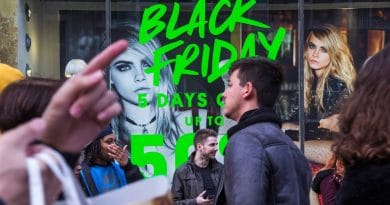Fashion Briefing: Why brands are still betting on physical showrooms
This week, a look at the lasting power of physical showrooms.
As owner Betsee Isenberg tells it, 10Eleven served as a creative hub during a time when people in fashion felt free to create. And, as a result, the 33-year-old showroom shaped the contemporary market as it’s known today.
“In the first 20 years, it was a different business,” she said of her company, which now has locations in L.A., NYC and Dallas. “We worked with brands on product [merchandising] and marketing, and we worked hand-in-hand with stores.”
In the late ’90s to early aughts, as e-commerce was still emerging, 10Eleven got Vince and Andrew Rosen’s Theory off the ground. It also fueled the relaunch of Diane von Furstenberg. Stylist Andrea Lieberman came to Isenberg with design sketches, which led to the 2009 launch of her ALC brand.
“There wasn’t a strategy,” Isenberg said. “Back in the day, you could throw something against the wall and see if it sticks.”
That’s a sharp contrast to her operations today, which are increasingly being shaped by retailers’ stringent demands.
“It’s all a numbers game,” she said. “You’re working with planners, as opposed to artists. And they’re risk-averse. Rather than a true partnership where you take risks together, they’re putting all the risk on the manufacturer.” She added that 10Eleven’s vast canceled orders in 2020 forced her to downsize her 40-person staff. She now has 20 employees. And she had to fall back on selling to off-price retailers for the first time, to keep manufacturer payments on track.
Since the start of the pandemic, in the name of survival, companies across the industry have upped their prioritization of saving money. For traditional retailers, changing consumer behaviors have led to new competition with e-tailers and marketplaces. Plus, more brands are phasing out of wholesale partnerships, having realized their DTC capabilities and the current necessity of higher margins. More than 5,000 stores closed in 2021, according to Coresight Research.
But even with the rise of wholesale marketplaces including NuOrder and Joor, the physical showroom model is holding on. That was evidenced last week when French brand Ba&sh, which is backed by LVMH’s L Catterton, announced 10Eleven as its exclusive wholesale retailer in North America.
“We were very selective in choosing the partner that was going to represent us in the U.S.,” said Desiree Thomas, CEO of Ba&sh North America. Thomas also served as evp of sales at 10Eleven from 2012-2016. “Having inside knowledge 10Eleven’s operations was super helpful. Betsee’s approach is collaborative, thoughtful and strategic; it’s not just about [defining] a brand’s distribution strategy, but it’s also about being an advisor as the brand works toward a vision.”
“Plus,” she added, “there’s no substitute for an in-person conversation.”
Isenberg said that 10Eleven set up a virtual showroom in early 2020, but subsequently folded it. “It was fun for a day,” she said. “If you’re a true retailer, you need to touch, feel and see the product. If it’s a hobby, you can do it online.”
The necessity of touch and feel, for end consumers, is also a popular justification for brands launching physical stores. Likewise, ensuring their stores are more than just points of sale has become high on retailers’ priorities. They’re competing with e-commerce sites and the comforts of home, while physical showrooms are up against the convenience and travel-free process of scrolling on a wholesale platform.
The same goes for physical trade shows, of course. For its part, 9-year-old Brand Assembly competes on curation, education and discovery, when it comes to earning retailers’ business. The company, which also focuses on the contemporary market, has worked with brands including LoveShackFancy and Scotch & Soda since day one. Many of its new clients are multi-brand showrooms that have recently been forced to close their own physical locations.
Already this year, Brand Assembly’s hosted markets in Atlanta and Dallas, both of which saw “decent” attendance, said Hillary France, co-founder and CEO of Brand Assembly. It will kick off a pre-fall show in L.A. on Monday.
“We’re creating a space that buyers want to come to because of the brand selection we offer and the stories we tell,” said France, noting the overwhelming number of contemporary brands on the market. “Plus, thanks to consistently providing an accessible, fun environment, we’ve built a strong community.”
Within the last two years, Brand Assembly temporarily teamed with a platform to host a virtual version of its shows. Since ending the partnership, France has been working to come up with a more customized virtual concept that would allow content and discovery to be front and center. “I shouldn’t be the one telling retailers how to place an order; they can transact on a number of other platforms,” she said. “I should be the one telling them what to order.”
Other services Brand Assembly offers brands include managing logistics, operations and accounting.
10Eleven has also remained choosy when forming brand partnerships. It currently houses a comfortable nine brands, after accumulating its record of 13 brands pre-pandemic. Out of the four that fell off, three had been with 10Eleven for 20 years. Each was for a different reason: One opted to focus on DTC sales, another closed after finding themselves knee-deep in supply chain issues.
Overall, Isenberg sticks to “financed” brands with potential. ”When you’ve been doing this as long as I have, you know in your gut who has the talent, the work ethic and the drive,” she said.
For brands that are startups, 10Eleven can serve as an incubator, as it did with ALC, setting them up with contacts from manufacturers to investors to PR professionals. “I don’t like to think of myself as a middleman or an agent,” said Isenberg. “I like to think that I’m on the same team as the brand, or a corporate extension.”
On the flip side, 10Eleven only partners with retailers that are at least six months old, to ensure they’re stable enough to fulfill manufacturer payments. Isenberg also studies their “brand matrix” to ensure alignment with 10Eleven’s brand roster.
“I’ve always been a volume driver, which is why some brands come to me and some don’t,” she said. “I’m the best at what I do because I’m very focused: the domestic market, women’s ready-to-wear, a [filtered] selection of brands.”
Meanwhile, Brand Assembly is considering expanding its focus to lifestyle categories, including gifts and home decor. According to France, buyers are starting to attend a greater variety of markets to round out their assortments with items that fit their aesthetic and “ring the register.”
Digital wholesale platforms are doing so, too. Joor, which announced a $46 million funding round in June, entered the home goods category in 2020. It currently sells more than 12,500 brands to 325,000 retailers, and processes more than $18 billion in annual transactions.
For its part, NuOrder, which was acquired by software company Lightspeed for $425 million in June, works with 3,000 brands and 100,000 retailers. The company will announce its newest retail partner, Intermix, on Tuesday.
It’s worth noting that both of these digital platforms have increasingly focused on providing retailers with personalization and opportunities for discovery. What’s more, some of the industry’s biggest physical trade shows have recently been canceled, due to safety concerns surrounding Omicron. Project canceled its January 4 men’s trade show in New York. And while Pitti Uomo played out earlier this week, several designers including Bruno Cucinelli and Ann Demeulemeester backed out due to safety concerns.
Tanya Taylor, who launched her namesake contemporary brand in 2012, linked with 10Eleven soon after, motivated by Isenberg’s “great product instinct, strong retail relationships and [insight] on growth opportunities,” she said. After five years, in 2019, she ended the partnership, after hiring a president to lead wholesale growth and bringing sales in-house.
Even so, she said she’s a big proponent of physical showrooms, particularly those that provide complementary services and especially for emerging brands.
“As many brands start to focus on their direct-to-consumer business and retailers turn to social media to discover emerging brands, the success of showrooms today lies in what else they can provide beyond sales,” she said. “As a new brand without the right network, a showroom that can bring in the right buyers is so important in laying the foundation for the business.”
For her part, France plans to stay the course with her physical focus. “The fashion industry is always going to be finicky,” she said. “So we just want to stick to what we know and what we love.”
And, according to Isenberg, it’s only a matter of time before fashion recycles itself, working to her advantage. “When you only focus on commerce, everything [in stores] starts to look the same, and it creates a demand for art. We’ve always married art and commerce, or magic and logic.” And, despite certain emerging digital trends, that’s easier done offline.
Reading List
Inside our coverage
Brands are launching mobile apps to alleviate supply chain issues.
DAOs could have a big impact on the fashion industry.
J.Jill is “keeping the focus on full price.”
What we’re reading
Luxury brands are playing it safe for the Lunar New Year.
Nike and Lululemon are among retailers shortening store hours as Omicron cases spike.
Your grandmother’s quilt is today’s luxury fashion staple.


